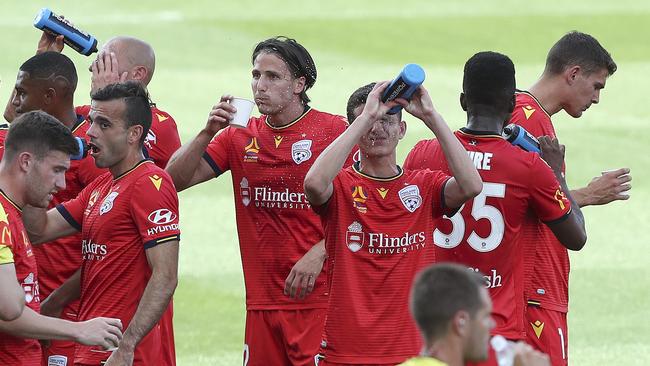A-League: Weather turns up heat on Australian soccer’s scheduling
It’s the “existential” crisis that Australian soccer has to face as it collides with weather that tests athletes to their limits.

It’s the “existential” crisis that Australian soccer has to face as it collides with weather that tests athletes to their limits.
With summer temperatures rising around Australia since the A-League began in 2005, games are being played in increasingly difficult conditions — and next season the challenges will get significantly worse.
This weekend, W-League and A-League fixtures have had to be rescheduled due to extreme heat forecasts, and A-League officials are counting their blessings that both the Melbourne derby and Friday night’s clash between Western Sydney and Western United fell on days sandwiched by brutal temperatures in both cities. From player welfare to the quality of the product, the challenges posed by hotter summers are already influencing the planning of the draw for next season’s A-League, W-League and National Youth League (NYL).
The arrival of Macarthur FC into the A-League next season means a sixth game to include, where for much of the season there are only five “natural” weekend slots: at 7.30pm on Friday, Saturday and Sunday, and an early evening game on each day of the weekend. When Perth play at home on Saturday night, the time difference with the Eastern Seaboard allows for a sixth game, but there are only seven of those in this year’s schedule.
Playing fixtures concurrently is anathema to broadcasters, but kicking off in the mid-afternoon is when summer temperatures are at their highest. The challenges for the W-League and NYL are even more stark, and W-League players have long complained of being forced to play in the heat of the day to avoid clashes with A-League games.
Australian soccer is hardly the only sport to face these challenges — the Australian Open tennis and cycling’s Tour Down Under are also grappling with temperature rises. But Martin Rice, head of research at The Climate Council, warns that “the beautiful game could turn ugly” here if practical solutions are not found.
“Nine of the 10 hottest years on record have come since the A-League began in 2005, and over the past decade we’ve had a record number of ‘wild weather’ days,” Rice said. “Sports administrators are going to have to factor this in when they schedule their fixture lists and it’s not going to get any better.
“All of the major sites where the A-League plays are forecast to see temperature rises of between 0.6-0.9C (in summer) by 2030. In specific terms, Adelaide for example now has 20 days a year where the temperature is over 35C.”
Current arrangements allow for games to be moved when forecasts exceed the so-called “Wet Bulb Globe Temperature” reading, which factors in temperature but also humidity, cloud cover, solar radiation, wind, shade, and the time of day.
The level at which games come in to question is actually lower in the A-League than FIFA mandates, but even where fixtures can go ahead, the heat has implications, says John Didulica, CEO of the players association.
“You have the problem of aggregate fatigue — when you play and train in consistently hot weather it can expose you to greater risk of soft-tissue injuries for instance,” he said.
It also affects the quality of the league if games slow to a walking pace. But the reality is that all long-term solutions are systemic — most radically, moving football to a winter sport, and having to go head to head with Australia’s other big codes.
Other options are commercially difficult, such as having midweek games in school holidays, playing regularly on Thursday or Monday nights, or accepting that not every game each round can be played in a different timeslot. With the advent of streaming and multichannel broadcast options, that seems the most palatable.
But doing nothing simply isn’t feasible.
“It’s an existential question that needs to be addressed by all of us,” said Didulica. “It’s an even more pressing concern for the W-League and NYL, whose athletes are potentially more exposed to extreme heat.’’
THE DAILY TELEGRAPH




To join the conversation, please log in. Don't have an account? Register
Join the conversation, you are commenting as Logout